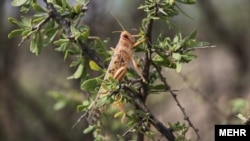Massive swarms of desert locusts (Schistocerca gregaria) have been arriving in Iran’s southern regions since late February. Government officials say the invasion is too huge to counter except with the use of pesticides.
Reza Mir, Spokesman of Plant Protection Organization, on Tuesday said the locusts have invaded the provinces of Hormozgan, Sistan and Baluchestan, Bushehr, Fars and Khuzestan.
“The density of locusts in the swarms is so high that a 10 to 15-centimeter layer of dead locusts forms on the ground after spraying pesticides,” he said.
According to Mir biological methods such as using ducks or mechanical entrapment of locusts is ineffective due to the dimensions of the problem and time constraints. “Allowing the pests to [recreate] is much more damaging than the side-effects of using chemical pesticides.
Locust swarm in Lar, Fars Province, February 2020
More than one million hectares of agricultural lands may be sprayed this year, Mohammad-Reza Dargahi, Head of the Plant Protection Organization said on Tuesday.
On Friday Keykhosrow Changalvai, Head of Agricultural Jihad Organization of the south-western province of Khuzestan, said the number of locusts is predicted to be seven-fold compared with the attack last year.
Locusts swarms invaded the same provinces in the south of Iran in April 2019, infecting hundreds of thousands of hectares of agricultural land.
“Last year the swarms were between one to one and a half kilometer long but this year they measure between seven to 10 kilometers".
Locust swarm in Hormozgan Province of Iran, February 2020
“The danger of these locusts is not less than coronavirus,” Changalvai said and added that they will remain in the region at least for the next three months.
Unlike the attack last year, the swarms of locusts that have attacked Iranian regions are immature, officials say, and more damaging as they will eat everything on their way.
The Food and Agriculture Organization of the United Nations (FAO) has placed Iran among the hot spots of the locust crisis along with Eritrea, Sudan Pakistan, Afghanistan, Iraq, Oman, Yemen, Saudi Arabia.
“Twenty-two immature swarms spread out along the southwest coast where they quickly matured within four days to lay eggs. Local breeding has continued in the southeast and control operations are in progress,” the latest update by FAO said on March 2.
Locust swarm in Kish Island, Iran, February 2020
According to FAO, the situation remains extremely alarming in the Horn of Africa, specifically Kenya, Ethiopia and Somalia where widespread breeding is in progress and new swarms are starting to form.
The desert locust is potentially the most dangerous of locust pests because of the ability of swarms to fly rapidly across great distances at a speed of up to 150 kilometer in one day. Even a one square kilometer locust swarm can eat the same amount of food in one day as about 35,000 people and recreates one to five generations per year.
Plagues of desert locusts have threatened agricultural production in Africa, the Middle East, and Asia for centuries. The livelihood of at least one-tenth of the world's human population can be affected by this voracious insect.






